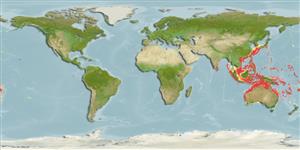Environment: milieu / climate zone / depth range / distribution range
Οικολογία
Θαλασσινό(ά) βενθικό(ς); εύρος βάθους 4 - 390 m (Ref. 9824). Tropical
Eastern Indian Ocean and Western Pacific: Bay of Bengal to southern Japan, Taiwan, New Caledonia, and several areas of the Indo-Australian Archipelago (Ref. 9824).
Μέγεθος / Βάρος / Age
Maturity: Lm ? range ? - ? cm
Max length : 24.0 cm TL αρσενικό/απροσδιόριστο; (Ref. 9824)
Ραχιαίες άκανθες (συνολικά) : 0; Μαλακές ραχιαίες ακτίνες (συνολικά) : 100 - 114; Εδρικές άκανθες: 0; Μαλακές εδρικές ακτίνες: 78 - 91. Mouth rather small, contained2. to 2.6 times in head length, maxillary extending to below the anterior margin or anterior 1/3 of lower eye. Gill rakers present on upper limb. Caudal fin with 2 simple rays on upper and lower margins. In the male, several anterior dorsal rays somewhat elongated.
Inhabits sandy substrates in coastal bays to deep offshore (Ref. 48637). Feeds on benthic animals.
Life cycle and mating behavior
Maturities | Αναπαραγωγή | Spawnings | Egg(s) | Fecundities | Προνύμφες
Masuda, H., K. Amaoka, C. Araga, T. Uyeno and T. Yoshino, 1984. The fishes of the Japanese Archipelago. Vol. 1. Tokai University Press, Tokyo, Japan. 437 p. (text). (Ref. 559)
IUCN Red List Status (Ref. 130435)
Threat to humans
Harmless
Human uses
αλιεία: χωρίς ενδιαφέρον
Εργαλεία
Special reports
Download XML
Διαδικτυακές πηγές
Estimates based on models
Preferred temperature (Ref.
123201): 16.4 - 27.8, mean 23.6 °C (based on 607 cells).
Phylogenetic diversity index (Ref.
82804): PD
50 = 0.5000 [Uniqueness, from 0.5 = low to 2.0 = high].
Bayesian length-weight: a=0.00912 (0.00408 - 0.02036), b=3.05 (2.87 - 3.23), in cm total length, based on LWR estimates for this (Sub)family-body shape (Ref.
93245).
Τροφικό Επίπεδο (Ref.
69278): 3.5 ±0.37 se; based on food items.
Ελαστικότητα (Ref.
120179): Μεσαίο(α), ελάχιστος χρόνος για διπλασιασμό πληθυσμού 1,4 - 4,4 έτη (Preliminary K or Fecundity.).
Fishing Vulnerability (Ref.
59153): Low vulnerability (14 of 100).
